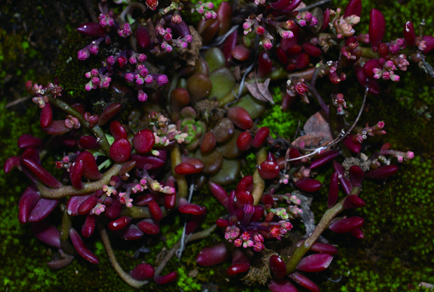Abstract
A new species, Sinocrassula adpressa (Crassulaceae), is described and illustrated from Yunnan Province, southwest region of China in present study. Morphologically, S. adpressa can easily recognized by stem purple red with spots, leaves purple red with spots, petals central protrusion with red stripe, sepals obovate-triangle and purple. A phylogenetic analysis based on four plastid markers and one nuclear marker supported the new species as mostly closely related to S. ganluoensis and S. obliquifolia.
References
- APG IV. (2016) An update of the angiosperm phylogeny group classification for the orders and families of flowering plants: APG IV. Botanical Journal of the Linnean Society 181: 1–20. https://doi.org/10.1111/boj.12385
- Averyanov, L.V., Byalt, V.V., Vinh, N.T., Loc, P.K. & Hieu, N.Q. (2014) Sinocrassula vietnamenis (Crassulaceae), new species and new generic record in the flora of Vietnam. Taiwania 59: 348–352. https://doi.org/10.6165/tai.2014.59.4.348
- Berger, A. (1930) Crassulaceae. In: Engler, A. & Prantl, K. (Eds.) Die natürlichen Pflanzenfamilien 2. pp. 352.
- Fu, K.-J. & Ohba, H. (2013) Crassulaceae. In: Wu, Z.Y. & Raven, P.H. (eds.) Flora of China. Vol. 8. Science Press, Beijing and Missouri Botanical Garden Press, St. Louis, pp. 202–268.
- Hoang, D.T., Chernomor, O., Haeseler, A.V., Minh, B.Q. & Vinh, L.S. (2018) UFBoot2: improving the ultrafast bootstrap approximation. Molecular Biology and Evolution 35: 518–522. https://doi.org/10.1093/molbev/msx281
- IUCN (2023) Guidelines for using the IUCN Red List categories and criteria, version 14. Prepared by the Standards and Petitions Committee. [https://www.iucnredlist.org/resources/redlistguidelines]
- Kalyaanamoorthy, S., Minh, B.Q., Wong, T.K.F., von Haeseler, A. & Jermiin, L.S. (2017) ModelFinder: fast model selection for accurate phylogenetic estimates. Nature Methods 14: 587–589. https://doi.org/10.1038/nmeth.4285
- Katoh, K. & Standley, D.M. (2013) MAFFT multiple sequence alignment software version 7: improvements in performance and usability. Molecular Biology and Evolution 30: 772–780. https://doi.org/10.1093/molbev/mst010
- Li, R.-J., Zhao, J., Fang, S.-L., Chen, C., Luo, M., Zhou, X.-M. & Wang, J.-G. (2024) Sinocrassula ganluoensis (Crassulaceae), a new species from China. Phytotaxa 675: 079–086. https://doi.org/10.11646/phytotaxa.675.1.7
- Li, R.-J., Zhao, J., Fang, S.-L., Huang, C.-J., Luo, M., He, Z.-R., Zhou, X.-M. & Wang, J.-G. (2025) Sinocrassula obliquifolia (Crassulaceae), a new species from China. PhytoKeys 255: 103–112. https://doi.org/10.3897/phytokeys.255.142079
- Morikawa, T., Xie, H., Wang, T., Matsuda, H. & Yoshikawa, M. (2008) Bioactive constituents from chinese natural medicines. XXXII. aminopeptidase N and aldose reductase inhibitors from Sinocrassula indica: structures of sinocrassosides B(4), B(5), C(1), and D(1)–D(3). Chemical and Pharmaceutical Bulletin 56: 1438–1444. https://doi.org/10.1248/cpb.56.1438
- Nguyen, L.T., Schmidt, H.A., von Haeseler, A. & Minh, B.Q. (2015) IQ-TREE: a fast and effective stochastic algorithm for estimating maximum likelihood phylogenies. Molecular Biology and Evolution 32: 268–274. https://doi.org/10.1093/molbev/msu300
- Ronquist, F., Teslenko, M., van der Mark, P., Ayres, D.L., Darling, A., Höhna, S., Larget, B., Liu, L., Suchard, M.A. & Huelsenbeck, J.P. (2012) MrBayes 3.2: efficient bayesian phylogenetic inference and model choice across a large model space. Systematic Biology 61: 539–542. https://doi.org/10.1093/sysbio/sys029
- Van Hinsbergen, D.J.J., Lippert, P.C., Dupont-Nivet, G., McQuarrie, N., Doubrovine, P.V., Spakman, W. & Torsvik, T.H. (2012) Greater India Basin hypothesis and a two-stage Cenozoic collision between India and Asia. Proceedings of the National Academy of Sciences of the United States of America 109: 7659–7664. https://doi.org/10.1073/pnas.1117262109
- Wang, J., Du, F. & Liu, Y. (2012) Sinocrassula stenosquamata (Crassulaceae), a new species from Yunnan, China. Acta Botanica Boreali-Occidentalia Sinica 32: 2563–2565. https://doi.org/10.3969/j.issn.1000-4025.2012.12.030
- Wang, J.-G., Chen, C., Wang, Y. & He, Z.-R. (2022) Sinocrassula jiaozishanensis (Crassulaceae), a new species from Yunnan Province, China. Phytotaxa 541: 010–020. https://doi.org/10.11646/phytotaxa.541.1.2
- Xie, H.-H. & Yoshikawa, M. (2012) Grasshopper ketone 3-O-primveroside from Sinocrassula indica. Journal of Asian Natural Products Research 14: 503–507. https://doi.org/10.1080/10286020.2012.669376
- Xu, Z.-B., Zhao, J., Li, R.-J., Jiang, H., Wang, J.-G. & Chen, Chao (2025) Sinocrassula holotricha (Crassulaceae), a new species from Sichuan, China. PhytoKeys 251: 241–250. https://doi.org/10.3897/phytokeys.251.134633
- Zhao, J., Nakamura, N., Hattori, M., Yang, X.-W., Komatsu, K. & Qiu, M.-H. (2004) New triterpenoid saponins from the roots of Sinocrassula asclepiadea. Chemical and Pharmaceutical Bulletin 52: 230–237. https://doi.org/10.1248/cpb.52.230


